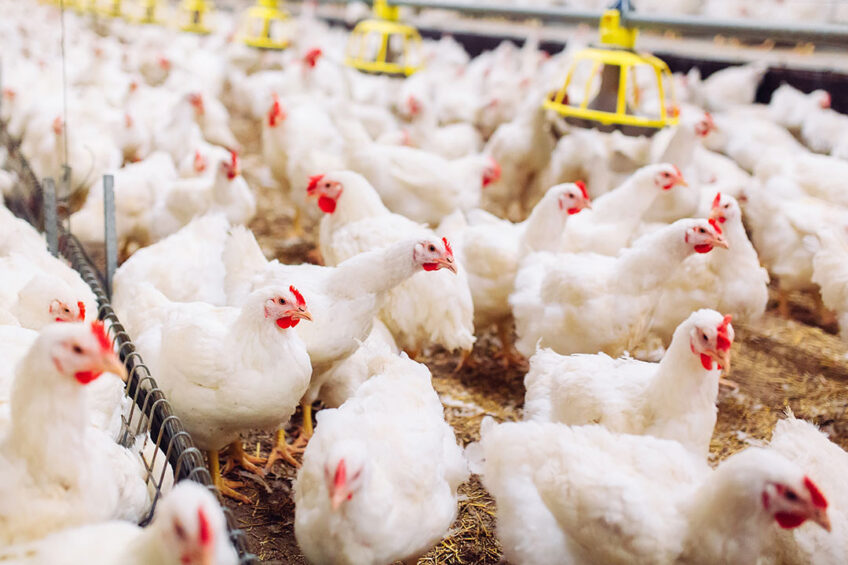Binding bacterial and fungal toxins in poultry

How will producers replace the benefits achieved with subtherapeutic antibiotic use in animal rations? That’s a question occupying many nutritionists and veterinarians that have made the switch to antibiotic-free production.
Although it’s unlikely a single feed additive will ever completely replace the efficacy and performance benefits of antibiotics, there are solutions available that can address multiple poultry industry challenges. One of the products on the market is Calibrin-Z from Amlan International, a natural, mineral-based feed additive that binds both bacterial and fungal toxins.
One of the biggest challenges for the poultry industry, particularly after the removal of in-feed antibiotics, is bacterial enteritis caused by pathogens like Escherichia coli and more notably, Clostridium perfringens, the causative agent of necrotic enteritis. Add production losses associated with mycotoxin-contaminated feed, and you have two industry challenges that urgently need a natural control solution.
Binding bacterial toxins and mycotoxins
Calibrin-Z isn’t your run-of-the-(feed)mill ingredient. It’s a highly efficacious, mineral-based feed additive that helps protect the intestinal health of poultry and livestock by adsorbing a broad spectrum of bacterial toxins and mycotoxins in the intestinal tract which are then eliminated harmlessly in the faeces. Unlike comparable products, it binds polar and nonpolar mycotoxins – that means aflatoxins, plus zearalenone, fumonisin, ochratoxin and T-2 toxin. It also binds the bacterial toxins that cause significant economic losses to producers, including C. perfringens-produced alpha-toxin and NetB toxin, as well as various exotoxins and endotoxin (LPS) from E. coli.
The additive has these impressive binding capabilities due to its specific chemical and structural properties that – together with Amlan’s proprietary thermal processing method – promote the adsorption of a broad spectrum of microbial toxins. Thermal processing is a natural method that does not alter the chemical composition of Calibrin-Z and so avoids the harmful chemicals typically used by other companies to activate their mineral-based products.
The mode of action for Calibrin-Z isn’t just about adsorbing microbial toxins; it can also quench the quorum-sensing molecules that pathogenic bacteria use to communicate. Preventing cell-to-cell communication disrupts the expression of virulence genes that could lead to infection in the bird.
Performance benefits
The production benefits of Calibrin-Z were demonstrated in a broiler mycotoxin challenge study that evaluated the ability of various feed additives to reduce the toxic effects of concurrent aflatoxin and fumonisin exposure. The study was conducted at Instituto de Soluções Analíticas Microbiológicas e Tecnológicas (SAMITEC) in Santa Maria, Brazil.
In the 21-day feeding trial, day-old male broiler chicks were randomly assigned to one of 6 dietary treatments that included 4 commercially available feed additives, sold as mycotoxin control products, added at an inclusion rate of 0.5%.
 A mycotoxin-challenged control diet was fed to all treatment groups except the unchallenged control (Table 1). The mycotoxins used in the challenge diet were aflatoxins B1, B2, G1 and G2 produced by Aspergillus parasiticus (1 ppm), and fumonisins B1 and B2 produced by Fusarium moniliforme (100 ppm). Aflatoxin B1 accounted for 93.8% of the aflatoxin added to the treatment diets and fumonisin B1 made up 95.8% of the cultured fumonisins added.
A mycotoxin-challenged control diet was fed to all treatment groups except the unchallenged control (Table 1). The mycotoxins used in the challenge diet were aflatoxins B1, B2, G1 and G2 produced by Aspergillus parasiticus (1 ppm), and fumonisins B1 and B2 produced by Fusarium moniliforme (100 ppm). Aflatoxin B1 accounted for 93.8% of the aflatoxin added to the treatment diets and fumonisin B1 made up 95.8% of the cultured fumonisins added. Broilers fed Calibrin-Z were numerically the most feed-efficient group and had the greatest numerical weight gain in all groups fed a mycotoxin-contaminated diet. Broilers fed Calibrin-Z were also statistically more feed-efficient and statistically gained more weight compared to the yeast cell wall-based and algae-based products (Figure 1).
Broilers fed Calibrin-Z were numerically the most feed-efficient group and had the greatest numerical weight gain in all groups fed a mycotoxin-contaminated diet. Broilers fed Calibrin-Z were also statistically more feed-efficient and statistically gained more weight compared to the yeast cell wall-based and algae-based products (Figure 1).
Safe and reliable
Performance and efficacy are important when deciding to incorporate a new feed additive into a ration but safety and reliability also need to be considered. Very few companies can say they own the clay mineral that goes into their feed additives, or that they control production all the way from the mine to the feed.
Vertical integration with Oil-Dri means Amlan controls every step of the production process to deliver safe and reliable, high-quality mineral-based products that are also processed in a sustainable manner. In the poultry industry’s search for alternatives to antibiotics, Calibrin-Z can improve poultry intestinal health by binding a broad spectrum of microbial toxins, thereby helping to control some of the most economically-significant challenges the industry currently faces.
References available on request.
 Beheer
Beheer











 WP Admin
WP Admin  Bewerk bericht
Bewerk bericht